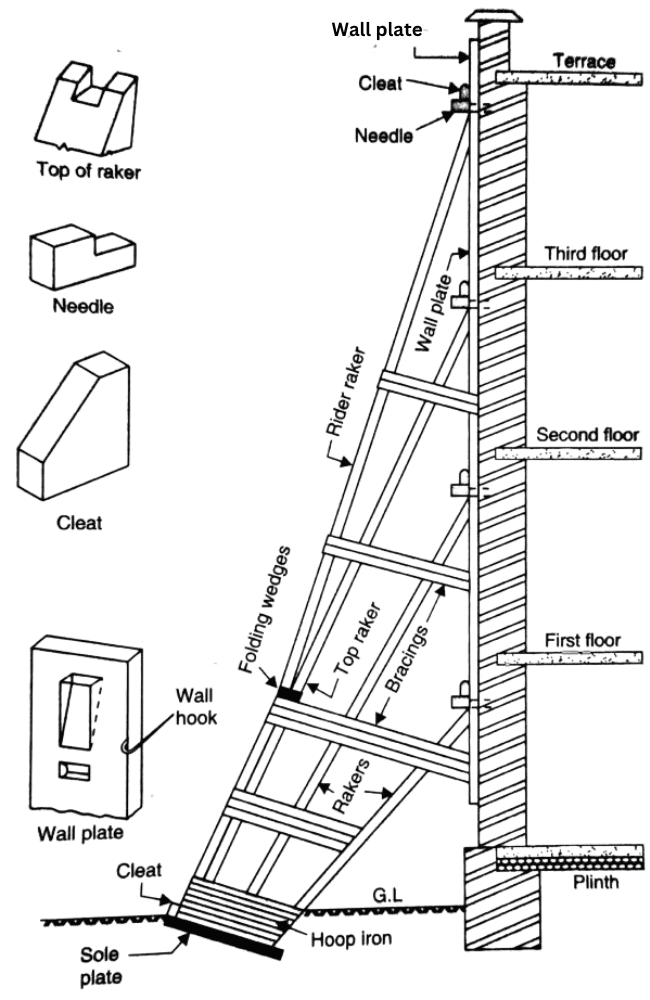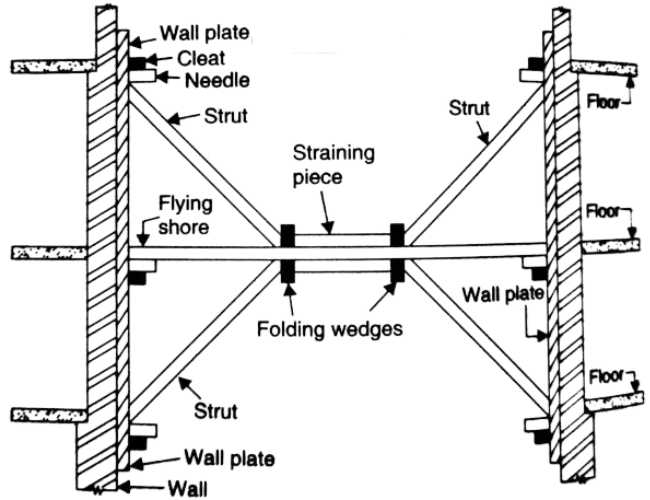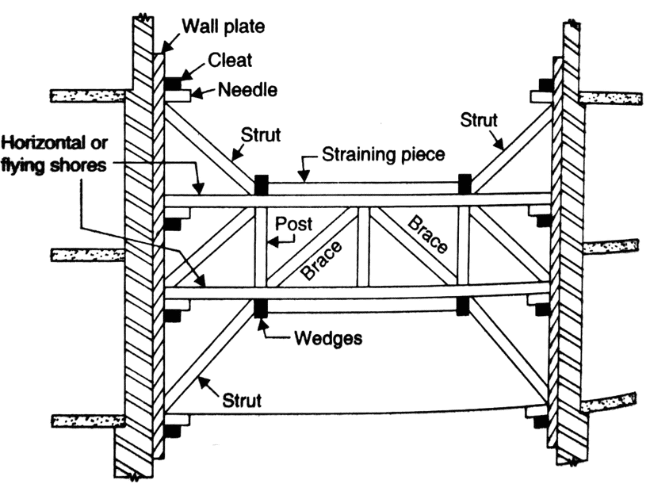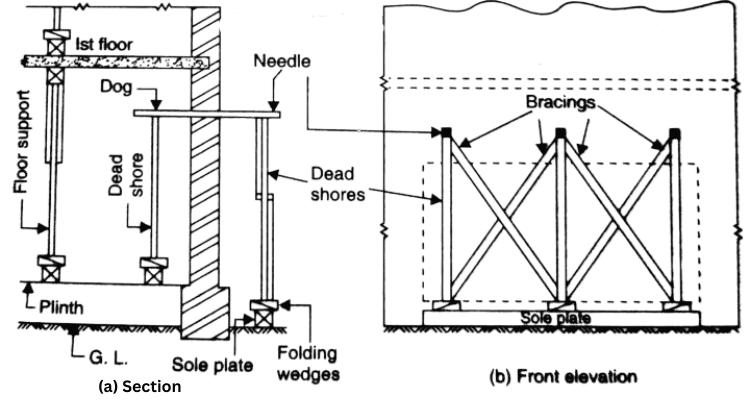Table of Contents
What is Shoring?
Shoring is the process of building a short-term structure to support an unstable one. Laterally, these support the walls.
Shoring can be utilized when a wall bulges out, when a wall cracks due to uneven foundation settling, when repairs need to be done, when a nearby structure needs to be torn down, or when openings need to be added to or widened in a wall.
Shoring is the technique of using shores (props) to temporarily support a building, vessel, structure, or trench when they are at risk of collapse or while undergoing repairs or modifications.
Shore-based shoring uses a wooden or metal support. Shoring could be horizontal, inclined, or vertical. Shoring is employed in the following circumstances:
- when a wall exhibits evidence of bursting out because of poor construction.
- Sometimes we must fix a wall crack brought on by uneven foundation settlement.
- when a nearby structure needs to be taken down.
- when openings in the wall need to be formed or widened.
Shoring is the temporary application of supports to a building or other structure. The Construction (Health, Safety, and Welfare) Regulations of 1996, in particular Regulations 9 and 10, must be followed when setting up and taking down a shoring system.
These have to do with working on structures where there is a potential for an unintentional collapse and hazard to everyone nearby or on the job site.
The Work at Height Regulations of 2005 also contains pertinent provisions pertaining to risk assessment. Shoring can last for a long period even if it is only a temporary solution while a permanent support structure is being constructed.
As a result, it is equally as significant as other construction-related factors. During assembly, disassembly, and any accompanying demolition, it must be subject to planned safety measures and professional supervision, regardless of how long it will be left in situ.
Types of Shoring
- Racking Shoring
- Flying Shoring
- Dead Shoring
Racking Shoring
This technique uses rakers, which are inclined members, to provide lateral supports for walls. The following elements make up a raking shore:
- Bracing
- Cleats
- Needles
- Rakers or inclined member
- Sole plate
- Wall plate

When using the raking shores, keep the following things in mind:
- Rakers must be 45° degrees incline in the ground. However, the angle could range from 45° to 75°.
- By adding a rider rake, the length of the rake can be shortened for tall buildings.
- Rakers need to be correctly braced periodically.
- Based on the predicted force from the wall, the size of the rakers should be chosen.
- A raker’s central line should intersect the wall at the floor.
- To cover the greater length of the bar, shoring may be positioned every 3 to 4.5 meters.
- The sole plate needs to be of the right section and size and be properly inserted into the ground at an angle.
- On sole plates, wedges shouldn’t be used because they can give way from the vibrations that are likely to happen.
Flying Shoring
When the intermediary structure is destroyed or falls, a support mechanism called flying shores gives two parallel party walls horizontal support.
Flying shores refers to any form of the shoring system used to sustain unstable structures where the shores do not extend to the earth. A single flying beach is appropriate if the walls are relatively close to one another (distance up to 9 m).

It is made up of folding wedges, struts, horizontal shore straining pieces, wall plates, and needle studs. A compound or double flying shore may be offered when the space between the walls is wider. With this technique, the building’s ground-level activities are not hindered.

When linking the flying coasts, the following considerations should be made:
- At floor levels of the two buildings, the center lines of the flying beaches, struts, and walls should intersect. If the floor levels differ, the horizontal shore should be placed at the weaker floor’s level or midway between the two equally strong floors.
- Preferably, the struts should be 45° angled. This inclination should never be greater than 60 degrees.
- Only up to a 9-meter gap between walls may single walls be used. There should be double switches available for longer distances. In that situation, it is necessary to symmetrically position both horizontal coastlines in relation to the floor levels.
- Along the two walls, the flying coasts should be spaced at 3 to 4.5 m intervals, and horizontal bracing should be added between neighboring shores.
- Because it is uncommon to estimate the real loads, the various shoring components in this system are determined using a high safety factor.
- Flying beaches are introduced and withdrawn after the construction of the new structure when there is a structural gap between two buildings as a result of the demolition of an older building.
Dead Shoring
In a dead shore shoring system, vertical elements that support horizontal needles that distribute the load of the wall, ceiling, floors, etc. act as a dead shore.
The needles convey the weight of the wall, etc., to the dead beaches.
The following uses are made for this kind of shoring:
- To repair the wall’s lower, faulty section.
- To build a new foundation or to extend the existing one.
- To cut a sizable hole in the lowest portion of an existing wall for underpinning and similar activities.
First, calculated-height holes are drilled into the wall. Then, large wood or steel sections are used as the needles, which are supported on both sides by dead shores or vertical pillars.
This shoring system is kept away from the wall to facilitate repairs. Plates and folding wedges are used to support and anchor dead coastlines.

For vertical shore, the following factors need to be taken into account:
- The load may be estimated with a reasonable degree of accuracy, and the section of needle and dead coasts should be ideal for the transfer.
- There are 1 to 2 meters between each needle. Three needles at the least should be used for the opening.
- Needles must be well supported or braced.
- The length of the outer shores is sometimes longer than the inner shores when an opening is formed in an external wall.
- The lifeless coastlines are supported by sole plates and are stable. Between the two, wedges that fold should be put. In a raw, using a single sole plate between dead coasts is preferred.
- The floors should have adequate internal support.
- Raking coasts are offered instead of a dead beach in the event that the exterior wall is weak.
- The scaffolding is taken down seven days after the construction is finished to ensure that the new work has sufficiently strengthened. The new work needs to be properly strutting.
- The following should be removed in order: needles, strutting from the opening, strutting inside the floor, and, if necessary, raking the shore every two days.
The use of shoring may be appropriate in the following circumstances:
- To provide support for weak or unsafe walls that are prone to sinking, bulging, or leaning.
- To prevent sound wall collapse brought on by the elimination of underlying support, as can occur when a basement is being built next to a sound wall.
- In the course of destruction to sustain a nearby building or structure.
- To provide support for an upper portion of a wall while the lower portion of the wall is being formed into a wide aperture.
- To sustain a floor or ceiling in order to remove a support wall and replace it with a beam.
- The typical material used for shoring members is structural softwood; it has a strength-to-weight ratio that compares favorably to structural steel and is more adaptable than steel.
- Shoring configurations can also be created by connecting sets of scaffold tubing.
Also, Read
Top Down Construction – Procedure, Advantages & Disadvantages
5 Essential Factors to Consider When Building A House
Lean to Roof – Materials, Advantages & Disadvantages | Lean to Roof Design
What is A Gable Roof? | 5 Types of Gable Roof